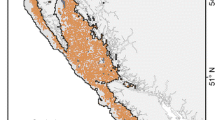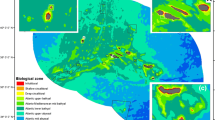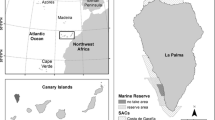Abstract
Marine protected areas (MPAs) can be an effective tool for marine biodiversity conservation, yet decision-makers usually have limited and biased datasets with which to make decisions about where to locate MPAs. Using commonly available abiotic and biotic datasets, I asked how many datasets are necessary to achieve robust patterns of conservation importance. I applied a decision support tool for marine protected area design in two regions of British Columbia, Canada, and sequentially excluded the datasets with the most limited geographic distribution. I found that the reserve selection method was robust to some missing datasets. The removal of up to 15 of the most geographically limited datasets did not significantly change the geographic patterns of the importance of areas for conservation. Indeed, including abiotic datasets plus at least 12 biotic datasets resulted in a spatial pattern similar to including all available biotic datasets. It was best to combine abiotic and biotic datasets in order to ensure habitats and species were represented. Patterns of clustering differed according to whether I used one set alone or both combined. Biotic datasets served as better surrogates for abiotic datasets than vice versa, and both represented more biodiversity features than randomly selected reserves. These results should provide encouragement to decision-makers engaged in MPA planning with limited spatial data.



Similar content being viewed by others
References
Agardy T (2000) Information needs for marine protected areas: scientific and societal. Bull Mar Sci 66:875–888
Airamé S, Dugan J, Lafferty KD et al (2003) Applying ecological criteria to marine reserve design: a case study from the California channel islands. Ecol Appl 13:S170–S184. doi:10.1890/1051-0761(2003)013[0170:AECTMR]2.0.CO;2
Ardron J (2002) A GIS recipe for determining benthic complexity: an indicator of species richness. In: Breman J (ed) Marine geography: GIS for the oceans and seas. ESRI Press, CA
Auster PJ, Joy K, Valentine PC (2001) Fish species and community distributions as proxies for seafloor habitat distributions: the Stellwagen bank national marine sanctuary example (Northwest Atlantic, Gulf Of Maine). Environ Biol Fishes 60:331–346. doi:10.1023/A:1011022320818
Ball IR (2000) Mathematical applications for conservation ecology: the dynamics of tree hollows and the design of nature reserves, PhD Thesis. The University of Adelaide
Ball IR, Possingham H (2000) Marxan (V1.8.2): marine reserve design using spatially explicit annealing, a manual
Beger M, McKenna SA, Possingham HP (2007) Effectiveness of surrogate taxa in the design of coral reef reserve systems in the Indo-Pacific. Conserv Biol 21:1584–1593
Booth AJ (2000) Incorporating the spatial component of fisheries data into stock assessment models. ICES J Mar Sci 57:858. doi:10.1006/jmsc.2000.0816
Brooks TM, da Fonseca GAB, Rodrigues ASL (2004) Protected areas and species. Conserv Biol 18:616–618. doi:10.1111/j.1523-1739.2004.01836.x
CBD (2006) Decisions adopted by the conference of the parties to the convention on biological diversity at its eighth meeting (Decision VIII/15, Annex IV). Convention on Biological Diversity, Curitiba, Brazil
Convention on Biological Diversity (2004) Convention on Biological Diversity: Indicators for assessing progress towards the 2010 target: coverage of protected areas. Convention on Biological Diversity, Bangkok, pp 1–12
Dahlgren CP, Sobel J (2000) Designing a dry tortugas ecological reserve: how big is big enough? to do what? Bull Mar Sci 66:707–719
Drew JA (2005) Use of traditional ecological Knowledge in marine conservation. Conserv Biol 19:1286–1293. doi:10.1111/j.1523-1739.2005.00158.x
Fernandes L, Day J, Lewis A et al (2005) Establishing representative no-take areas in the great barrier reef: large-scale implementation of theory on marine protected areas. Conserv Biol 19:1733–1744. doi:10.1111/j.1523-1739.2005.00302.x
Grand J, Cummings MP, Rebelo TG et al (2007) Biased data reduce efficiency and effectiveness of conservation reserve networks. Ecol Lett 10:364–374. doi:10.1111/j.1461-0248.2007.01025.x
Grantham HS, Moilanen A, Wilson KA et al (2008) Diminishing return on investment for biodiversity data in conservation planning. Conserv Lett 1:190–198
Halpern BS, Warner RR (2002) Marine reserves have rapid and lasting effects. Ecol Lett 5:361–366. doi:10.1046/j.1461-0248.2002.00326.x
Halpern BS, Walbridge S, Selkoe KA et al (2008) A global map of human impact on marine ecosystems. Science 319:948–952. doi:10.1126/science:1149345
Jackson JBC, Kirby MX, Berger WH et al (2001) Historical overfishing and the recent collapse of coastal ecosystems. Science 293:629–637. doi:10.1126/science.1059199
MP J (2007) JMP. SAS Institute Inc, Cary, North Carolina
Klein CJ, Chan A, Kircher L et al (2008) Striking a balance between biodiversity conservation and socioeconomic viability in the design of marine protected areas. Conserv Biol 33:691–700. doi:10.1111/j.1523-1739.2008.00896.x
Leslie H, Ruckelshaus M, Ball IR et al (2003) Using siting algorithms in the design of marine reserve networks. Ecol Appl 13:S185–S198. doi:10.1890/1051-0761(2003)013[0185:USAITD]2.0.CO;2
Mace GM, Balmford A, Boitani L et al (2000) It’s time to work together and stop duplicating conservation efforts. Nature 405:393. doi:10.1038/35013247
Margules CR, Pressey RL (2000) Systematic conservation planning. Nature 405:243–253. doi:10.1038/35012251
Myers RA, Worm B (2003) Rapid worldwide depletion of predatory fish communities. Nature 423:280–283. doi:10.1038/nature01610
NOAA (2007) West coast of North America living marine resources data atlas: digital version
Parnell PE, Dayton PK, Lennert-Cody CE et al (2006) Marine reserve design: optimal size, habitats, species affinities, diversity, and ocean microclimate. Ecol Appl 16:945–962. doi:10.1890/1051-0761(2006)016[0945:MRDOSH]2.0.CO;2
Pauly D, Christensen V, Dalsgaard J et al (1998) Fishing down marine food webs. Science 279:860–863. doi:10.1126/science.279.5352.860
Plan Development Team (1990) The potential of marine fishery reserves for reef fish management in the US southern Atlantic. NOAA technical memorandum NMFS-SEFC-261, Springfield, VA, p 40
Possingham HP, Ball IR, Andelman S (2000) Mathematical methods for identifying representative reserve networks. In: Ferson S, Burgman M (eds) Quantitative methods for conservation biology. Springer-Verlag, New York, pp 291–305
Pressey RL, Cowling RM (2001) Reserve selection algorithms and the real world. Conserv Biol 15:275–277. doi:10.1046/j.1523-1739.2001.99541.x
Pressey RL, Possingham HP, Margules CR (1996) Optimality in reserve selection algorithms: when does it matter and how much? Biol Conserv 76:259–267. doi:10.1016/0006-3207(95)00120-4
Pressey RL, Possingham HP, Day JR (1997) Effectiveness of alternative heuristic algorithms for identifying indicative minimum requirements for conservation reserves. Biol Conserv 80:207–219. doi:10.1016/S0006-3207(96)00045-6
Roberts CM (2000) Selecting marine reserve locations: optimality versus opportunism. Bull Mar Sci 66:581–592
Roberts CM, Bohnsack JA, Gell F et al (2001) Effects of marine reserves on adjacent fisheries. Science 294:1920–1923. doi:10.1126/science.294.5548.1920
Roberts CM, Andelman S, Branch G et al (2003a) Ecological criteria for evaluating candidate sites for marine reserves. Ecol Appl 13:S199–S214. doi:10.1890/1051-0761(2003)013[0199:ECFECS]2.0.CO;2
Roberts CM, Branch G, Bustamente RH et al (2003b) Application of ecological criteria in selecting marine reserves and developing reserve networks. Ecol Appl 13:S215–S228. doi:10.1890/1051-0761(2003)013[0215:AOECIS]2.0.CO;2
Rondinini C, Wilson KA, Boitani L et al (2006) Tradeoffs of different types of species occurrence data for use in systematic conservation planning. Ecol Lett 9:1136–1145. doi:10.1111/j.1461-0248.2006.00970.x
Sala E, Knowlton N (2006) Global marine biodiversity trends. Annu Rev Environ Resour 31:93–122. doi:10.1146/annurev.energy.31.020105.100235
Sala E, Aburto-Oropeza O, Paredes G et al (2002) A general model for designing networks of marine reserves. Science 298:1991–1993. doi:10.1126/science.1075284
Smith R, Goodman P, Matthews W (2006) Systematic conservation planning: a review of perceived limitations and an illustration of the benefits, using a case study from Maputaland, South Africa. Oryx 40:400–410. doi:10.1017/S0030605306001232
Stewart RR, Noyce T, Possingham HP (2003) Opportunity cost of ad hoc marine reserve design decisions: an example from South Australia. Mar Ecol Prog Ser 253:25–38. doi:10.3354/meps253025
Stewart RR, Ball IR, Possingham HP (2007) The effect of incremental reserve design and changing reservation goals on the long-term efficiency of reserve systems. Conserv Biol 21:346–354. doi:10.1111/j.1523-1739.2006.00618.x
Tetreault I, Ambrose RF (2007) Temperate marine reserves enhance targeted but not untargeted fishes in multiple no-take MPAs. Ecol Appl 17:2251–2267. doi:10.1890/06-0161.1
Ward T, Vanderklift M, Nicholls A et al (1999) Selecting marine reserves using habitats and species assemblages as surrogates for biological diversity. Ecol Appl 9:691–698. doi:10.1890/1051-0761(1999)009[0691:SMRUHA]2.0.CO;2
Warman LD, Sinclair ARE, Scudder GGE et al (2004) Sensitivity of systematic reserve selection to decisions about scale, biological data, and targets: case study from southern British Columbia. Conserv Biol 18:655–666. doi:10.1111/j.1523-1739.2004.00538.x
Wood LJ, Fish L, Laughren J, et al (2007) Assessing progress towards global marine protection targets: shortfalls in information and action. UBC Fisheries centre working paper series #2007-03: 1–39
World Summit on Sustainable Development (2003) World summit on sustainable development plan of implementation (oceans section). World Summit on Sustainable Development
Zacharias MA, Howes DE, Harper JR et al (1998) The British Columbia marine ecosystem classification: rationale, development, and verification. Coast Manage 26:105–124. doi:10.1080/08920759809362347
Acknowledgments
This is a contribution from Project Seahorse. I am grateful for helpful comments on earlier versions of this manuscript by Amanda Vincent, Mike Jones, Gretchen Anderson Hansen, Krista Royle, Ralph Wells and colleagues at Project Seahorse. I would like to thank all the organizations and agencies who kindly provided data or made their data publicly accessible: Fisheries and Oceans Canada, NOAA, Province of British Columbia, and Living Oceans Society. I was supported by The Canon National Parks Science Scholars Program, the National Science and Engineering Research Council of Canada, and NSERC-IPS with CPAWS-BC. This work was facilitated by support from the John G. Shedd Aquarium, through its partnership in marine conservation with Project Seahorse and by Guylian Chocolates Belgium. Two anonymous reviewers improved the manuscript.
Author information
Authors and Affiliations
Corresponding author
Appendix
Appendix
Rights and permissions
About this article
Cite this article
Ban, N.C. Minimum data requirements for designing a set of marine protected areas, using commonly available abiotic and biotic datasets. Biodivers Conserv 18, 1829–1845 (2009). https://doi.org/10.1007/s10531-008-9560-8
Received:
Accepted:
Published:
Issue Date:
DOI: https://doi.org/10.1007/s10531-008-9560-8




